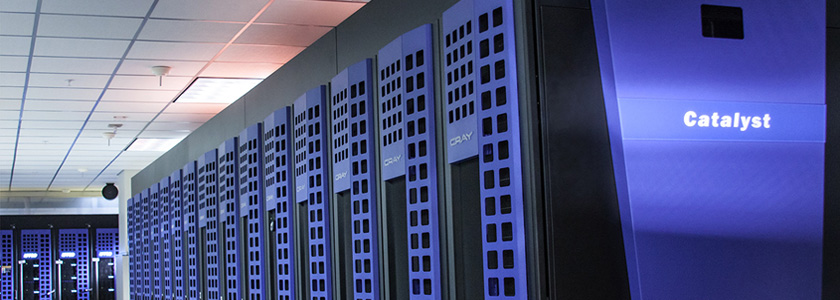The 150 teraflop/s Catalyst, a unique high-performance computing (HPC) cluster, serves as a proving ground for new HPC and big data technologies, architectures, and applications. Developed by a partnership of Cray, Intel, and Lawrence Livermore, this Cray CS300 system is available for collaborative projects with industry through Livermore’s HPC Innovation Center. Catalyst also supports the LLNL’s Advanced Simulation and Computing program.
Catalyst features include 128 gigabytes of dynamic random access memory (DRAM) per node and 800 gigabytes of non-volatile memory (NVRAM) per compute node. The increased storage capacity of the system represents a major departure from classic simulation-based computing architectures common at Department of Energy laboratories and enables researchers to explore the potential of combining floating point-focused capability with data analysis in one environment. In addition, the machine’s expanded DRAM and fast, persistent NVRAM are particularly well suited to solving big data problems, such as those found in the areas of bioinformatics, graph networks, machine learning, and natural language processing, or for exploring new approaches to application checkpointing, in-situ visualization, out-of-core algorithms and data analytics. Catalyst should help extend the range of possibilities for the processing, analysis, and management of the ever larger and more complex data sets that many areas of business and science now confront.
Catalyst is limited access.
| Zone |
CZ
|
| Vendor |
Cray
|
| User-Available Nodes |
Login Nodes*
2
Batch Nodes
300
Debug Nodes
4
Total Nodes
324
|
| CPUs |
CPU Architecture
Intel Xeon E5-2695 v2
Cores/Node
24
Total Cores
7,776
|
| Memory Total (GiB) |
41,472
|
| CPU Memory/Node (GiB) |
128
|
| Clock Speed (GHz) |
2.4
|
| Peak single CPU memory bandwidth ((GiB)/s) |
60
|
| OS |
TOSS 3
|
| Interconnect |
IB QDR
|
| Scheduler |
srun
|
| Recommended location for parallel file space |
/p/lustre[1,2]
|
| Program |
ASC, M&IC
|
| Compilers | |
| Documentation |


